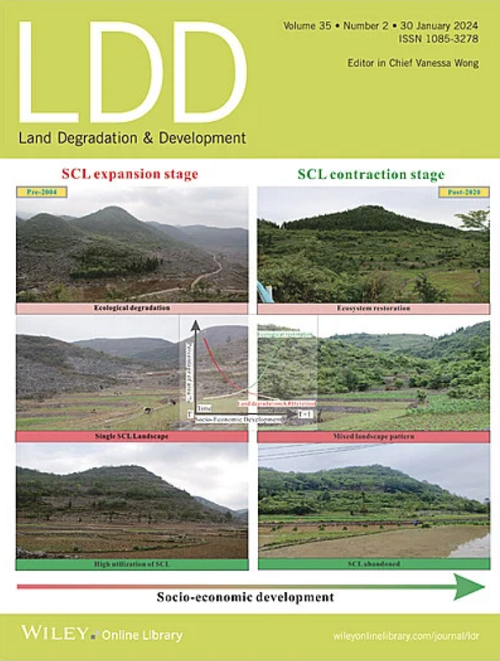不同治沙措施对高寒沙地表层土壤的改良效果
IF 3.7
2区 农林科学
Q2 ENVIRONMENTAL SCIENCES
引用次数: 0
摘要
高寒沙地水土流失严重,养分含量低,生态环境脆弱,需要采取有效的治理措施来改善沙质土壤。本文对不同治沙措施对高寒沙地表层土壤的改善效果进行了评价。对共和盆地高寒沙地土壤进行了调查。以流动沙丘裸地(LD)样品为对照,与尼龙沙障(NL)、板岩沙障(SB)、柠条人工林(NT)和荒漠蒿人工林(SH) 4种不同处理策略下的陆地样品进行了比较。利用Illumina高通量测序技术测定土壤理化性质和酶活性,分析细菌群落结构。这四种措施都显著降低了含砂量。NL和SB对土壤养分含量和酶活性的影响最小,而NT和SH显著提高了土壤养分和酶活性,其中SH的影响最为显著。NT和SH显著增加了细菌群落丰富度,特别是在0-10 cm层。有效磷是影响细菌群落结构的主要理化因素。此外,在所有4个试验区,酶活性与大多数主要细菌门的相对丰度呈显著相关。植树造林措施对共和盆地高寒沙土的改良效果显著,其中以松林造林效果最好。研究结果可为其他高寒沙区的治沙策略提供参考,并为沙土微环境的生态修复提供理论依据。本文章由计算机程序翻译,如有差异,请以英文原文为准。
Effectiveness of Different Sand Control Measures in Improving the Surface Soil in Alpine Sandy Land
Alpine sandy land suffers from serious soil erosion, low nutrient content, and a fragile ecological environment, necessitating effective control measures to improve sandy soil. In this study, the effectiveness of different sand control measures in improving the surface soil of alpine sandy land is evaluated. Soils from alpine sandy land of the Gonghe Basin were investigated. Samples from mobile sand dune bare ground (LD) were used as a reference and were compared with samples from land under four different treatment strategies: nylon sand barriers (NL), slate sand barriers (SB), Caragana korshinskii Artemisia desertorum plantations (SH). Soil physicochemical properties and enzyme activity were measured, and bacterial community structure was analyzed using Illumina high‐throughput sequencing. All four measures significantly reduced the sand content. NL and SB had minimal effect on the soil nutrient content and enzyme activities, whereas NT and SH significantly increased both parameters, with SH showing the most pronounced effects. NT and SH significantly increased the bacterial community richness, especially in the 0–10 cm layer. Available phosphorus was the primary physicochemical factor influencing the bacterial community structure. Additionally, the enzyme activities showed significant correlations with the relative abundance of most major bacterial phyla in all four experimental plots. Afforestation measures, especially with SH, were effective in improving the alpine sandy soil in the Gonghe Basin. These results provide a reference for sand control strategies in other alpine sandy areas and a theoretical basis for the ecological restoration of sandy soil microenvironments.
求助全文
通过发布文献求助,成功后即可免费获取论文全文。
去求助
来源期刊

Land Degradation & Development
农林科学-环境科学
CiteScore
7.70
自引率
8.50%
发文量
379
审稿时长
5.5 months
期刊介绍:
Land Degradation & Development is an international journal which seeks to promote rational study of the recognition, monitoring, control and rehabilitation of degradation in terrestrial environments. The journal focuses on:
- what land degradation is;
- what causes land degradation;
- the impacts of land degradation
- the scale of land degradation;
- the history, current status or future trends of land degradation;
- avoidance, mitigation and control of land degradation;
- remedial actions to rehabilitate or restore degraded land;
- sustainable land management.
 求助内容:
求助内容: 应助结果提醒方式:
应助结果提醒方式:


